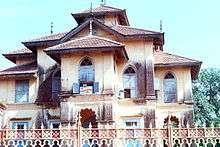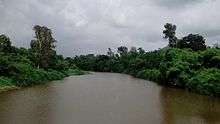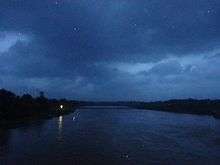Dharampur, India
| Dharampur | |
|---|---|
| city | |
| Nickname(s): vimal | |
 Dharampur  Dharampur Location in Gujarat, India | |
| Coordinates: 20°32′N 73°11′E / 20.53°N 73.18°ECoordinates: 20°32′N 73°11′E / 20.53°N 73.18°E | |
| Country |
|
| State | Gujarat |
| District | Valsad |
| Elevation | 74 m (243 ft) |
| Population (2001) | |
| • Total | 19,932 |
| Languages | |
| • Official | Gujarati, Hindi |
| Time zone | IST (UTC+5:30) |
| Vehicle registration | GJ |
| Website |
gujaratindia |
Dharampur is a city and a municipality in Valsad district in the state of Gujarat, India.
Geography
Dharampur is located at 20°32′N 73°11′E / 20.53°N 73.18°E.[1] It has an average elevation of 74 metres (242 feet). Dharampur is the small and beautiful town situated at just far away from Valsad. In the serene setting of Sahyadri Foothills, Dharampur is situated on the banks of the Swargavahini River and is surrounded by the Sahyadri mountain range on the east, west and south sides. Due to its location, the town enjoys a very pleasant climate throughout the year.Dharampur was created in 1262 as Ramnagar and the first king of this state was Maharana Ramsinh. You can see the entrance of Dharampur town in the picture which is erected in commemoration of Maharana Vijaydevji, selected as the king on 2 March 1921. The "Dharampur" name is given by "Dharamdev" in 1766 as capital of Ramnagar. Before, its name was "Mandvengan town".

History
Dharampur, situated in south Gujarat, was a capital of the former princely State of Dharampur. Originally, it was known as Ramnagar. The present day Dharampur dates back to 1764 AD and was founded by King Dharmdevji. The descendants of the Sisodia Rajputs of Chittor ruled in the history of Dharampur. After the fall of the Delhi Sultanate in south Gujarat, the State of Dharampur flourished and gained a very significant and powerful position by controlling at least seven strategic forts in the region.

The Dharampur State was surrounded by the Muslim states of Khandesh, Ahmednagar and Gujarat Sultans, but because of its strategic importance, was never attacked by the Muslims. Even the 'Parsis' found political patronage under the Dharampur kings. The Dharampur kings had cordial relations with Portuguese traders from the south Gujarat ports and used to receive tax revenue from them. Development in Phases the City of Dharampur had two major phases of development the first in the late 18th century, when the Rana undertook the construction of Raj Mahal, public buildings, stepwells and temples. The second phase was in the late 19th century, when as a part of the Queen Victoria Golden Jubilee celebrations, the Anglo Vernacular School, jail and hospitals was constructed. King Mohandevji (1891-1921 AD) studied at Rajkumar College, Rajkot and introduced many reforms. Under his patronage, Mohan Vilas Palace, Pramod Bhavan, State guesthouse and several temples were constructed. Roads, water tanks and bridges were built to improve the infrastructure of the state. King Vijaydevji, on his accession to kingdom in 1921, constructed a museum and dedicated it to Lady Wilson. Vijaydevji undertook extensive travelling to collect rare and genuine art objects for display in museum. He was a great patron of art and music and a well-known musician, with equal command over both Indian and western classical music. He wrote a treatise on music 'Sangeet Bhav' in six volumes, with Gujarati, Hindi, English and French notations. He was also fond of hunting and constructed a hunting lodge at Audha and residences at Wilson Hills as summer retreats. The town has a very beautiful entrance gate (Rajya Rohan Gate) done in European style with life-size statues in Greek style adorning the top. Bandstand and gymkhana building are located, near the gate. In the old days, the State Band used to play music in the evenings for the citizens of Dharampur, at the BandStand.

Dharampur today is home to the international headquarters of the Shrimad Rajchandra Mission. The mission's international headquarters is located on the hillock of Mohangadh.
In the year 1900 A.D., Shrimad Rajchandraji had consecrated the soil of Dharampur for about 35 days (from chaitra sud ekam to vaishakh sud pancham, V.S. 1956). He had spent much of this time in solitude, at the crematorium and in the surrounding jungles, immersed in spiritual bliss.
Scenic Dharampur - Beginning of Sahyadri Range

Dharampur falls under beginning region of sahyadri range of mountains, its is the starting point of the most scenic region of the Gujarat State a true tourism potential. As falls on foot hills of sahyadri Range a starting point of Western Ghat which starts from District of Tapi and Ends at Kanyakumari in South India. Dharampur as part of western ghat comes under eight "hottest hotspots" of biological diversity in the world.
Road leading from Dharampur to Kaprada to Nasik is the most scenic road of Gujarat ever seen with up and down roads and land covered with Green carpets in monsoon season.
Dharampur has lots of river tributaries and river trajectory maneuvering around hills and valley to create mesmerizing views and ideal for river cruise and bird watching.
Swarg Vahini is the river passing through town of Dharampur and people says that nobody knows where it starts from and where it ends.
While river Dhamni a tributary at 20 km from Dharampur emerges from deep jungles and creates a scene of Amazon of Gujarat.
Night view of the river Swarg Vahini and beautiful photo of river Dhamni taken by a local photo enthusiastic Rajendra Kumar Pavar endorses how pristine and beautiful is our Dharampur located in Gujarat, I will say its is lost city in wilderness of foriegn trips.

Tribal Belt
Dharampur and is surrounding witness habitat of Tribal Peoples of Southern Tribal Belt. Tribal people of the region were very poor before indepence but due right government policies and social work done by some of the prominent gandhian followers like Premshankar Bhatt, Urmillaben Bhatt, Kalanji Kaka who started Tribal Ashram under name of Dakshin Gujarat Adivasi Sevamandal' gave major contribution in educating tribal kids since 1948.